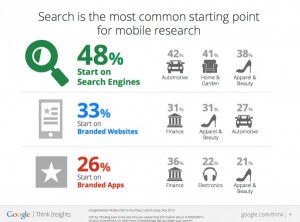As of March 2014, the average car dealer website gets more traffic from mobile devices (including laptops) than from desktop computers. Many of the dealers that we work with have no idea how their traffic breaks down between desktop, laptop, tablet, and phone. They are used to visiting their dealership’s website on a desktop computer at the dealership or from their home at night, so they have a good understanding of how their site looks for customers using their dealership’s site on a desktop computer. But most dealers don’t spend enough time understanding the mobile customer experience on their website.
According to Google, search is the most common starting point for mobile research. In fact, 42% of automotive shoppers start on search engines, while 27% of automotive shoppers start on branded websites. Those are both huge percentages of people looking for your dealership online – but how do you know if your mobile site is delivering what they need?

The best way to learn whether or not your dealership mobile website solution, regardless of which technology platform you’re using, is meeting the needs and expectations of your visitors is to use Google Analytics. GA data can help you determine if your adaptive website design is set up properly. For example, if mobile traffic is visiting traditional, desktop pages, you have a problem with your adaptive design or switchboard tags. Do you have a disproportional bounce rate on your mobile site? This could indicate that your website isn’t showing properly to mobile visitors.

DealerOn has talked before about the importance of having Google Analytics on your dealership website, and how to use that data to sell more cars, but with the drastic shift to mobile internet usage, dealers need to make sure that their website provider has coded their site so they can easily measure site performance on mobile vs. desktop vs. tablet at a minimum.
It’s also important to understand how to analyze your website data differently for traditional and mobile website visits. Your dealership should probably be tracking different KPIs for mobile traffic than you do for desktop. For instance, some of the most common and important KPIs for desktop traffic are:
- Bounce Rate
- Time on Site
- Pages per Visit
- VDP’s per Visit
- Leads
- Conversion Rate
- Calls
For mobile traffic, many of these may not be appropriate. In fact, you may just want to track things like Calls, Clicks to Maps, and Vehicle Views for your website’s mobile traffic. Whatever KPIs you want to measure for mobile, you should make sure that you work with your website provider to set up goals that can measure each of these metrics and ideally assign a value to each of them so you can begin to measure the return on your mobile traffic.
These are the types of questions you need to talk to your digital marketing provider (or website company) about to make sure you’re getting the readily available, valuable data out of your Google Analytics. It is no longer just a good idea to measure, analyze, and optimize your website’s mobile traffic. In 2014, it is essential to getting the most out of your marketing budget.


